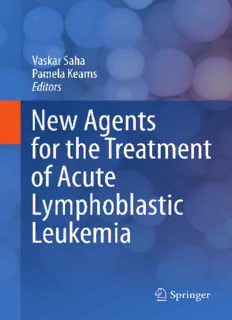
New Agents for the Treatment of Acute Lymphoblastic Leukemia PDF
Preview New Agents for the Treatment of Acute Lymphoblastic Leukemia
New Agents for the Treatment of Acute Lymphoblastic Leukemia Vaskar Saha Pamela Kearns ● Editors New Agents for the Treatment of Acute Lymphoblastic Leukemia Editors Vaskar Saha Pamela Kearns Paediatric and Adolescent Oncology School of Cancer Sciences School of Cancer and Enabling Sciences University of Birmingham Manchester Academic Health Science Edgbaston, Birmingham B15 2TT Centre [email protected] The University of Manchester Manchester M20 4BX [email protected] ISBN 978-1-4419-8458-6 e-ISBN 978-1-4419-8459-3 DOI 10.1007/978-1-4419-8459-3 Springer New York Dordrecht Heidelberg London Library of Congress Control Number: 2011925850 © Springer Science+Business Media, LLC 2011 All rights reserved. This work may not be translated or copied in whole or in part without the written permission of the publisher (Springer Science+Business Media, LLC, 233 Spring Street, New York, NY 10013, USA), except for brief excerpts in connection with reviews or scholarly analysis. Use in connection with any form of information storage and retrieval, electronic adaptation, computer software, or by similar or dissimilar methodology now known or hereafter developed is forbidden. The use in this publication of trade names, trademarks, service marks, and similar terms, even if they are not identified as such, is not to be taken as an expression of opinion as to whether or not they are subject to proprietary rights. While the advice and information in this book are believed to be true and accurate at the date of going to press, neither the authors nor the editors nor the publisher can accept any legal responsibility for any errors or omissions that may be made. The publisher makes no warranty, express or implied, with respect to the material contained herein. Printed on acid-free paper Springer is part of Springer Science+Business Media (www.springer.com) Brief Overview Over 80% of children with acute lymphoblastic leukemia (ALL) are cured by modern chemotherapeutic regimens. These are the results of carefully conducted randomised clinical trials. Mainly, current protocols have progressively intensified therapy for all children and now use risk stratification to intensify treatment for high-risk subgroups. As a result, therapy-related toxicity now outweighs disease recurrence as a determinant of outcome. The prognosis for those who relapse or do not respond to therapy remains poor. Further intensification is unlikely to benefit those who fail therapy and may increase toxicity for those who do. Perhaps, the most intense of therapies is allogeneic bone marrow transplantation. However, dis- ease recurrence is the most common cause of transplantation failure in these patients. The drugs that we use for ALL are now over 30 years old. To improve outcome further and to decrease toxicity, we need new drugs. These are exciting times. At long last, new agents that can potentially be used in the ALL armamentarium are increasing rapidly. These include both conventional cytotoxics and targeted therapy. However, there are a number of problems that need to be solved. How does one evaluate the effect of a new drug in a disease where over 80% of patients are cured from what is otherwise a fatal disease? What are acce ptable surrogate markers of response to treatment given that therapeutic failure can occur over a number of years? With shrinking number of patients suitable for phase I and II trials, what new models of trial design are required to obtain answers in the quickest possible time? What cellular and animal models will we accept as most predictive for the clinical effect of the drug in question? These are some of the questions that need to be answered before we can incorporate new agents into frontline therapy for patients with ALL. v Acknowledgements This work was funded in part by a programme grant from Cancer Research UK to Vaskar Saha. The editors thank Ms Charlotte O’Horo for editorial assistance. vii Contents 1 The Need for New Agents ....................................................................... 1 Tim Eden 2 Identifying Targets for New Therapies in Children with Acute Lymphoblastic Leukemia .................................................... 25 Shekhar Krishnan, Ashish Masurekar, and Vaskar Saha 3 Preclinical Evaluation ............................................................................. 39 Barbara Szymanska, Hernan Carol, and Richard B. Lock 4 Design of Early-Phase Trials .................................................................. 61 James A. Whitlock and Terzah M. Horton 5 Strategies for Trial Design and Analyses .............................................. 83 Maria Grazia Valsecchi and Paola De Lorenzo 6 An Overview on Animal Models of ALL .............................................. 105 Michael A. Batey and Josef H. Vormoor 7 Targeting Bcl-2 Family Proteins in Childhood Leukemia ................... 117 Guy Makin and Caroline Dive 8 Targeting Leukemia Stem Cells and Stem Cell Pathways in ALL ..................................................................................... 143 Clare Pridans and Brian J.P. Huntly 9 Nucleoside Analogues ............................................................................. 167 Pamela Kearns and Vaskar Saha 10 FLT3 Inhibitors as Therapeutic Agents in MLL Rearranged Acute Lymphoblastic Leukemia ....................................... 189 Ronald W. Stam and Rob Pieters ix
Description: